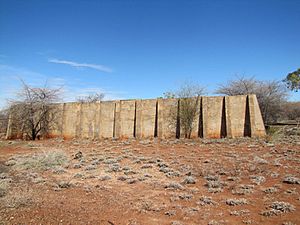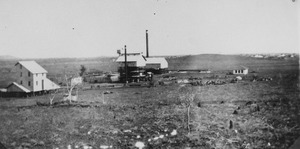Mount Elliott Company Metallurgical Plant and Mill facts for kids
Quick facts for kids Mount Elliott Company Metallurgical Plant and Mill |
|
|---|---|

Buttressed tank, 2013
|
|
| Location | Via Sheaffe Street, Cloncurry, Shire of Cloncurry, Queensland, Australia |
| Design period | 1919 - 1930s (interwar period) |
| Built | 1926 - April 1927 |
| Official name: Mount Elliott Company Metallurgical Plant and Mill | |
| Type | state heritage (built, archaeological) |
| Designated | 17 June 2003 |
| Reference no. | 602256 |
| Significant period | 1926-1927 (fabric, historical) |
| Significant components | machinery/plant/equipment - mining/mineral processing, vat, flue, mounting block/stand, tank - storage, ramp |
| Lua error in Module:Location_map at line 420: attempt to index field 'wikibase' (a nil value). | |
The Mount Elliott Company Metallurgical Plant and Mill is a special historical site in Cloncurry, Queensland, Australia. It was a large factory built to extract metals like copper from ore. This plant was constructed between 1926 and April 1927. Today, its remains are protected as a heritage site, added to the Queensland Heritage Register on 17 June 2003.
Contents
A Brief History of the Plant
In the 1920s, the Mount Elliott Company wanted to control all the copper mining in the Cloncurry area. After some business deals, they finally took over most of the copper mines. However, they were running low on money, and copper prices were low.
To make things better, the company decided to try a new method. This method was invented by Henry Squarebrigs Mackay. It was a special way of using electricity to get copper from low-quality ores. This process is called electrolytic smelting.
Building the Plant
In 1926, the company began building this new plant in Cloncurry. It was designed to produce about 1,000 tonnes of copper each year. The plant was located next to the Great Northern railway line.
The construction finished in April 1927. This was the very first plant of its kind ever built. Henry Mackay himself watched over the building process in Cloncurry.
What the Plant Looked Like
The plant had several important parts. It included a crushing area to break down the ore. There was also a large furnace, about 6 metres wide, used for roasting the ore. This furnace had seven levels for roasting and one for drying.
The furnace was inside a steel building, about 11 by 11 metres and 12 metres tall. Gas was used as fuel to roast the ore.
Next, there was the leaching plant. This part had two large concrete tanks, each 9 by 18 metres and 3 metres deep. There were also four round concrete tanks, each 9 metres wide and 3 metres deep, for storing solutions.
The most advanced part was the electrolytic section. This was in a two-story steel building, 15 by 18 metres and 13 metres high. On the second floor, there were 24 wooden tanks. These tanks held electrolytic cells, which used electricity to separate the copper.
Powering the Plant
The plant needed a lot of power. The power station was in a separate steel building, 9 by 18 metres and 9 metres high. It had a large Babcock and Wilcox boiler with a tall, 37-metre steel chimney.
A powerful engine connected to a 400-kilowatt generator produced electricity. There was also a special cooling system. It had a concrete pool, 18 by 18 metres and 1.5 metres deep, with spray pipes. This system could cool 30,000 gallons of water every hour.
Why the Plant Closed
Even though the plant was finished, it never actually started working. Before it could even have a trial run, the company in London ordered it to close. The main reason was that it cost too much money to build, about £128,000. The company also thought the plant wasn't big enough to make enough profit.
Some people also said that the company might have used an idea that was already patented by someone else. However, the high building costs were likely the biggest reason for its closure.
What Remains Today
Today, you can still see the remains of this special plant. These remains are grouped into five main areas.
Crushing and Ore Dump Area
To the south, you'll find the area where ore was first brought in. There's a place where ore was dumped and an earth ramp for loading. You can also see concrete surfaces and foundations of old buildings and tanks. An iron flotation unit, which helps separate minerals, is also on the site, though not in its original spot.
Roasting Furnace Remains
Further north, you can see the concrete bases and foundations of the wedge roasting furnace. This includes parts of a flue (a channel for smoke) and the base of an iron chimney. There's also a vertical boiler and a concrete tank nearby.
Leaching Vats
To the west, there's a very large concrete leaching vat. It's about 20 metres square and 3 metres tall. This vat was used to dissolve the copper from the ore. Its walls are supported by strong concrete buttresses.
North of this, there are four more round concrete leaching vats. Each of these is about 11 metres wide and 3 metres tall.
Electrolytic Works Area
The northernmost group of structures is next to the Cloncurry - Mount Isa railway line. Here, you'll find concrete surfaces and foundations of the electrolytic works. This is where the copper was separated using electricity. There's also a brick flue and the base of an iron chimney. Three concrete tanks, each about 15 square metres and 1.5 metres deep, are also in this area.
Laboratory Foundations
The fifth part of the site is the foundations of what was once a laboratory. This building was made from mud bricks, covered with cement on both the inside and outside.
Some old plant equipment can still be seen, including a vertical boiler and a flotation unit.
Why This Site is Important
The Mount Elliott Company Metallurgical Plant and Mill was added to the Queensland Heritage Register on 17 June 2003. It's considered important for several reasons:
- It shows how Queensland's history developed. The plant's construction shows how hopeful the company was. They wanted a modern, central factory to process all the copper ore from their mines across the region.
- It shows rare or uncommon parts of Queensland's history. This plant is the only known surviving example of an early electrolytic plant in Queensland. Also, the remains of the laboratory are unique because they were built using "ant bed adobe bricks," which is an uncommon building material.
- It shows great technical achievement. The process used here was Henry Squarebrigs Mackay's own invention. The plant was designed in London, and it was the first of its kind ever built. Mackay himself oversaw its construction in Cloncurry.


